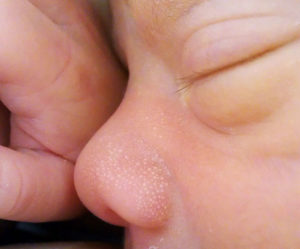If you do a quick internet search for the main conditions affecting babies, you’ll find huge lists packed with information—probably each one different from the next. This is no coincidence, but is because babies truly are fragile and are affected by various types of viruses, bacteria, and conditions1 that we cannot always avoid or completely control. This is the case with milia, for example, which, although it can appear in people of any age, is much more common in newborns. But what should you do when a newborn has milia? Can it be serious? Why does it appear? How is it treated? With all these questions in mind, we decided to write this article to explain each of these points for you.
What is Milia?
Milia are a type of white nodule that usually appear on the baby’s face. They are very common, with more than 2 million cases per year in Brazil. Milia are characterized by white or yellowish bumps, often appearing around the baby’s eyes, nose, and mouth2. The eye area is usually most affected, but these eruptions can appear anywhere on the body. This type of skin eruption is often mistaken for blackheads and pimples, but you should not squeeze milia because it contains keratin, the protein that makes up the skin. Although it is more common in newborns, milia can appear at any age, and it becomes more difficult to remove as a person gets older. Additionally, the type of milia a person develops can vary depending on their age.
Why Does Milia Appear in Newborns?
Milia is caused by a buildup of dead skin in small pockets, which are the eruptions we can see. It is believed that this dead skin gets trapped due to the blockage of the sebaceous and sweat glands. For this reason, milia is also more common in healing areas, as skin cell renewal is greater there. There are some risk factors that can lead someone to develop milia, such as skin diseases, serious burns, injuries, and long-term sun exposure.
Types of Milia
As mentioned earlier, the types of milia are related to age. While some types only appear in adults, any type can possibly appear in newborns depending on their conditions. The three types of milia that can be observed in newborns are:
- Neonatal Milia
- Primary Milia
- Secondary Milia
Let’s talk in more depth about each of them and explain how each type can appear in newborn babies.
Neonatal Milia
This usually occurs because the baby’s sweat glands are not yet fully developed and end up becoming trapped in these small pockets. Located mainly in the nose area, this type of milia in newborns usually disappears within a few weeks and occurs in about 50% of babies.
Primary Milia
Also quite common in newborns, primary milia can also appear in adults. Eruptions may also occur on the nose, forehead, cheeks, and even the genital area. It also disappears easily and causes no discomfort other than an aesthetic one.
Secondary Milia
This type of milia can also affect both newborns and adults, although it’s a bit rarer in very young babies. It is caused by some trauma to the skin, such as a burn or injury. Milia typically appears as the skin is healing. 
How to Treat Milia in Newborns?
Although there are various treatments such as chemical peels, skin cleansing, and even surgical milia removal, when it comes to newborns there is no need for any treatment. That’s because milia does not cause any harm and the main concern people have is only aesthetic, which is understandable but does not apply to newborns. Firstly, because milia in newborns usually disappears quickly within a few weeks, and secondly, because there is no sense in exposing a baby to products just to remove these eruptions, especially since it is something completely harmless.
How to Prevent Milia From Appearing?
In newborns, it is recommended not to try to prevent milia from appearing, since prevention would involve skin cleansing and using products that could be harmful to the baby. Milia is harmless and disappears in a very short time in babies, so it’s best to simply let these eruptions come and go naturally, without needing to intervene or try to prevent them from happening. As we have already mentioned, about 50% of babies are born with neonatal milia. It is very normal. Minor issues like milia in newborns will always come up. And although this is specifically harmless for babies, it is very common and even healthy for some of these problems to occur, as they help strengthen the baby’s immune system3 and may serve as a warning for more serious issues that could appear later. But that doesn’t mean you shouldn’t take proper care—on the contrary. These are the moments when you are put to the test to make sure your baby gets better quickly. We should always be careful and, even with small and seemingly harmless things, do everything possible to put the baby’s health first. Also See: Washing Your Hands Before Holding the Baby – Necessity or Exaggeration? Photo: Serephine











